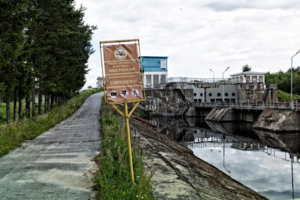Lake Kozar-Green Sea Canal
This article is incomplete because it is pending further input from participants, or it is a work-in-progress by one author. Please comment on this article's talk page to share your input, comments and questions. Note: To contribute to this article, you may need to seek help from the author(s) of this page. |
| Lake Kozar-Green Sea Canal Grand Canal | |
|---|---|
 A section of the Lake Kozar-Green Sea Canal located along the Česko-Gratislavian border | |
| Country | |
| Specifications | |
| Maximum boat beam | 14.3 m (46 ft 11 in) |
| Maximum boat draft | 6 m |
| Status | In partial service |
| History | |
| Current owner | Various states, in dispute |
| Original owner | |
| Geography | |
| Start point | Lake Tarasov, |
| End point | Green Sea |
The Lake Kozar-Green Sea Canal (Vysokaya Rech': Озерокозар-Зеленыйобувь Kанал, Ozerokozar-Zelenoyemore Kanal) and often referred to as the Grand Canal was a ship canal constructed by the Order of Soviet Socialist Republics between 1937 and 1963 designed to connect the five great lakes of northern Omand to the Green Sea. Though the canal actually begins in Lake Tarasov, located in the southern part of the Ekspander SSR, it is named for the larger Lake Kozar. The canal system uses a series of man-made rivers constructed through several nation's before ultimately converging with the Xhevahir River in northern Proizkhod, and following its course into the Green Sea. Overall, it is X kilometers n length, crossing 5 nations. In addition, the canal forms the border between Proizkhod and Icaria along the Xhevahir River.
The Grand Canal was constructed in lands either already possessed by the Soviet Order or through nation's invaded and occupied by it. The construction was mostly performed by prisoners within the Soviet penal system, prisoners of war, or civilians impressed into service by the Soviet occupation forces. In total, it is believed that over 25,000 laborers died during the 26 years of construction. At the time, the Grand Canal was the longest man-made water way on Omand, and is considered to be one of the great feats of engineering accomplished on the planet.
The canal system was heavily damaged during the Omandan Continental War and has been mostly abandoned following the withdrawal of Soviet Order forces from territories through which the canal passes. In general, vessels are able to safely travel up the Xhevahir River through Illyria and into South Lake, and from there into Lake Crescent. Further north, passing out of Lake Creasent and into Lake Kozar, the canal is impassible by commercial ships, but remain serviceable to smaller vessels. Although some nations which received possession of various parts of the canal, such as Gratislavia, have made no effort to improve or maintain the canal works, other nations, most notably Česko, have claimed to have repaired much of the canal's infrastructure and intend to return the canal works to service within the decade.
The Canal by Country
Badnaj
The Republic of Badnaj controls two distinct portions of the Lake Kozar-Green Sea Canal, the first (originally designated LKGS Canal Lock System #004, known today as both the Erdzhii section in Balkovaria and the Zubi section in Badnaj) connects Lake Perim and Lake Ribkapetna and serves as the Balkovarian border. The second (originally designated LKGS Canal Lock System #003, known today as the Arterija section) connects Lake Perim and Lake Acrno and serves as the border between Badnaj and Moravia. The Arterija section is administered and policed exclusively by the Twin Lake Canal Concern, following the treaty of Tsapol Badnaj maintains exclusive economic and administration rights despite the section forming the border with Moravia. LKGS #004 is jointly administered with Balkavoria, though only on an admnistrative level with security and policing handled exclusively by the Balkovarians.
Balkovaria
The Tsardom of Balkovaria controls two distinct portions of the Lake Kozar-Green Sea Canal, the first (originally designated LKGS Canal Lock System #005, known today as the Iliri Section) connects Lake Perim to the Green River which flows into the titular Green Sea. The second (originally designated LKGS Canal Lock System #004, known today as both the Erdzhii section in Balkovaria and the Zubi section in Badnaj) connects Lake Perim and Lake Ribkapetna and serves as the border between Badnaj and Balkovaria. Both sections that lie within the jurisdiction of Balkovaria are administered by the Green River Canal Authority (GRCA), but LKGS #004 also receives significant funding and is jointly administered in cooperation with the Badnaji Twin Lake Canal Concern. Balkovaria has invested significantly in the maintenance of the LKGS #004 and #005, bolstered by reciprocal investments from Badnaj at #004. The sections that lie in Balkovaria are considered major economic zones and contribute significantly to the GDP of the Tsardom. Policing and enforcement of sections #004 and #005 is handled exclusively by the GRCA, which maintains a significant paramilitary force as the Green River Berets.